| Previous | Contents | Index |
This chapter describes how to develop nonblocking desktop client programs for event-driven, multitasking environments such as OSF/Motif and X Windows.
The sample described in this chapter uses X Windows and the OSF/Motif toolkit. However, the guidelines presented here apply to any X-applications, including Open Look applications. Chapter 4 gives a useful background in the Desktop services provided in the portable API. Although the focus in that chapter is on DOS, the basic principles apply to OSF/Motif and X Windows as well. For information on designing your application with nonblocking services, see Chapter 2.
For information on configuring network transports for any of the client
platforms, see Compaq TP Desktop Connector for
ACMS Gateway Management Guide.
6.1 Event-Driven Processing
A Motif desktop client program must yield control to the X Windows system as quickly as possible so that other event processing can be handled in a timely way. The following TP Desktop Connector nonblocking services provide methods to facilitate yielding control:
Figure 6-1 shows the sequence of processing in an event-driven desktop client program.
Figure 6-1 Event-Driven Desktop Client Program Processing
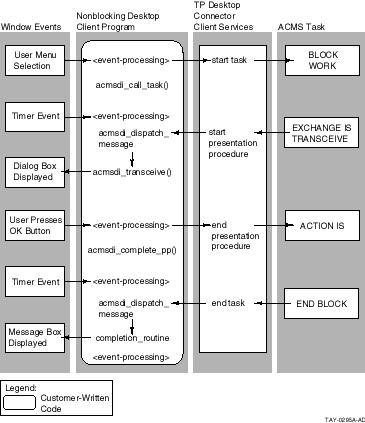
When the user selects a task from a menu, the desktop client program calls the acmsdi_call_task service to initiate an ACMS task. In the nonblocking environment, you specify nonblocking parameters in the call (see Section 9.5). For example, the address of a completion routine is a nonblocking parameter that you can include in the desktop client program. The TP Desktop Connector client service calls the completion routine when the TP Desktop Connector Gateway for ACMS completes the task. Because the completion routine parameter is specified in the call, the TP Desktop Connector client service is treated like a nonblocking service and returns control to the desktop client program immediately after the start task request is sent to the TP Desktop Connector gateway. The desktop client program does not wait for the gateway to request ACMS software to start a task in an ACMS application. Instead, the desktop client program returns control to XtMainLoop for more event processing.
The TP Desktop Connector client service also returns a call identification that the desktop client program supplies to the acmsdi_complete_pp service. The services use the call identification to associate an active call with a submitter. Note that TP Desktop Connector supports, at most, one active task for each submitter.
Because of an exchange step in the I/O task, the ACMS system starts a transceive operation. The gateway sends a message to the desktop client program to start a presentation procedure.
The acmsdi_dispatch_message service runs as part of the polling mechanism established by the desktop client program. The acmsdi_dispatch_message service polls for the message and, when the message is received, calls the customer-written presentation procedure acmsdi_transceive. The acmsdi_transceive routine runs, saves pointers to the workspaces, displays a dialog box, and returns control to X Windows without the user having to signal completion.
The user then has an opportunity to edit or add data to a form in the context of an exchange step. When the user later clicks on OK to signal completion, the desktop client program uses the saved workspace pointers to store the user-entered data, and calls the acmsdi_complete_pp service to send the workspaces and response status to the gateway. (The desktop client program does not wait for a response from the gateway. It returns control to XtMainLoop as soon as possible.) Meanwhile, the gateway passes to the ACMS task the workspaces and the status from the completion of the presentation procedure.
When the task completes on the ACMS system, the gateway sends the end task message to the desktop system. The TP Desktop Connector client services dispatch the end task message by calling a completion routine in the desktop client program. This completion routine is dispatched by the polling mechanism and acmsdi_dispatch_message.
The gateway sends a message to the desktop client program under two conditions:
The TP Desktop Connector client services dispatch the gateway
messages to the desktop client program by the polling mechanism
established.
6.2 Guidelines for Developing X Windows Desktop Client Programs
The following list summarizes general requirements and guidelines for developing X Windows nonblocking desktop client programs:
Optionally, you can do the following when developing a desktop client program:
The remainder of the chapter explains the guidelines using code from
the AVERTZ sample desktop client program.
6.3 AVERTZ Sample Desktop Client Program for X Windows
The Motif AVERTZ sample desktop client program is written in C and
follows the standards and practices outlined in the OSF/Motif Style
Guide. The program uses a main window, icons, and dialog boxes to
interact with the user.
6.3.1 AVERTZ Components for X Windows
A nonblocking X Windows desktop client program has some of the same high-level components as a blocking Desktop client (see Figure 6-2). Note the addition of the polling mechanism as well as the application-specific presentation procedures, which are split into two parts.
The m_avertz.exe program includes the following functional modules:
Figure 6-2 TP Desktop Connector Sample Components for X Windows
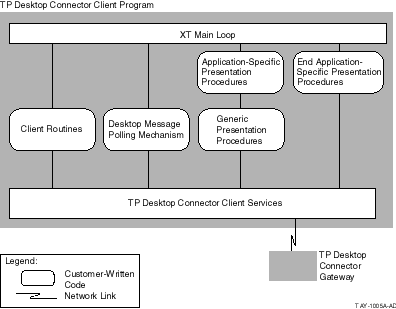
The desktop client program allows the user to maintain multiple sign-ins with the AVERTZ application, VR_DA_APPL. The program controls each sign-in by associating session context with the user sign-in data.
The desktop client program user interface presents menus with which the user interacts to sign in to and out of the ACMS system, run ACMS tasks, and control sessions:
Program-defined icons represent sessions. The user can double click on
an icon to bring up forms associated with a specific session. The icons
are also visual clues to active and inactive sessions.
6.3.2 AVERTZ Component Processing Flow
The m_avertz.c module contains the program initialization, XtMainLoop, and support for the main window. The following important functions are performed:
The m_session.c module contains the following session creation and control functions:
The New command in the session menu presents a dialog box to enable the user to sign in to the ACMS system, thereby creating a new AVERTZ session. After the user is signed in to the ACMS system, the desktop client program maintains session information to track, for example, the association between the form (or forms) of a given session and the corresponding ACMS submitter identification. The program also activates other menus to allow the signed-in user to select ACMS tasks. A session can have only one active task at any given time, but a user can sign in to the ACMS system many times, allowing multiple tasks to run simultaneously.
Individual modules handle the generic presentation procedures. For example, m_transceive.c handles the acmsdi_transceive presentation procedure called from the ACMS system, validates the parameters, and dispatches control to the appropriate application-specific presentation procedure.
The m_avertzpp.c module handles all application-specific presentation procedures for the AVERTZ desktop client program. Each presentation procedure comprises an initial routine, for example, Trans_List3_List2, and a completion routine, for example, End_Trans_List3_List2. The generic presentation procedures call the initial routine (the first part of the presentation procedure), which generally displays the data from the workspaces sent by the ACMS system and returns. Control returns to XtMainLoop so that the user can enter and receive data.
When the user signals completion (done entering data) for this presentation procedure, the corresponding completion routine is called. It collects the user-entered data and sends it to the ACMS system to complete processing of the presentation procedure.
The m_resvform.c module manages the reservation form for the reserve task, including field validation and initialization. When the user clicks on the OK or cancel button in the reservation form, the ResvFormExchangeComplete() routine dispatches the completion routine of the current presentation procedure. The following series of figures (Figure 6_3, Figure 6_4, Figure 6_5, and Figure 6-6) present the flow of a nonblocking service.
Figure 6-3 shows the user selecting the Create Reservation task from the Rental menu.
Figure 6-3 User Selects a Task
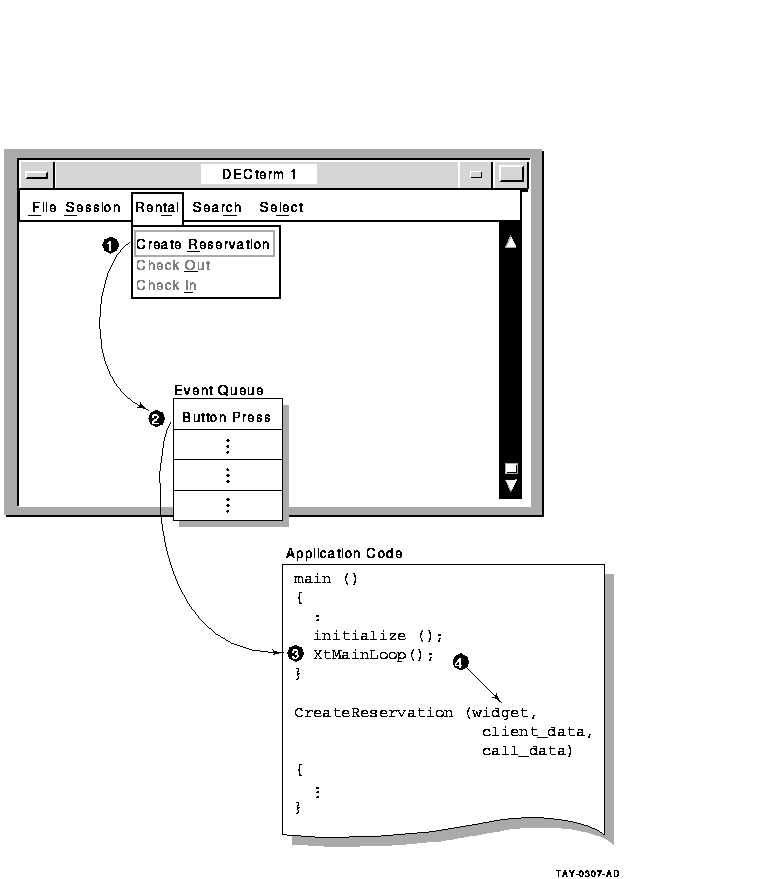
The following callouts describe the actions in Figure 6-3:
Figure 6-4 shows the flow of code in the nonblocking service.
Figure 6-4 Nonblocking Service
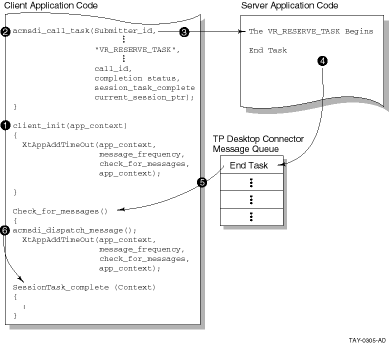
The following callouts describe the flow of code in Figure 6-4:
Figure 6-5 shows the I/O processing of a nonblocking service.
Figure 6-5 I/O Processing for a Nonblocking Service/Part 1
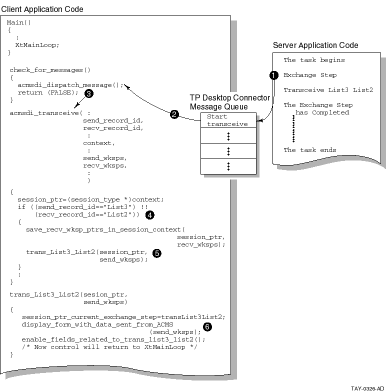
The following callouts describe the I/O processing flow for a task that has just been invoked:
Figure 6-6 shows the form displayed by the Trans_List3_List2() routine.
Figure 6-6 I/O Processing for a Nonblocking Service/Part 2

The following callouts described the processing in Figure 6-6:
The following sections describe how to structure procedures that use
nonblocking services.
6.4.1 Calling Nonblocking Services
Nonblocking forms of the services have the following differences from blocking forms:
The desktop client program periodically calls acmsdi_dispatch_message() to check for pending replies or requests from the gateway. When the client service completion message arrives, the acmsdi_dispatch_message() calls the completion routine in the desktop client program.
Example 6-1 shows the calls in the m_session.c module to the acmsdi_sign_in service that creates a new session, and to the companion completion routine NewSession_Complete that completes the service.
| Example 6-1 Nonblocking Service Call and Completion Routine |
|---|
extern void NewSession(
Widget widget,
int *client_data,
XtPointer call_data)
{
.
.
.
status = acmsdi_sign_in(
session_ptr->node,
session_ptr->username,
session_ptr->password,
(long) 0,
session_ptr->submitter_id,
&session_ptr->completion_status,
NewSession_Complete, (1)
(void *) session_ptr);
if (status == ACMSDI_PENDING) (2)
{
.
.
.
extern void NewSession_Complete(void *call_context) (3)
{
session_type *session_ptr;
Widget session_icon;
int i;
/* Get Session Node For This Sign In Completion */
session_ptr = (session_type *) call_context;
/*
** Check ACMS Return Status
** - If failure occurred, put up the error message and
** delete session from session list.
*/
if (session_ptr->completion_status != ACMSDI_NORMAL)
{
DisplayDesktopErrorMessage(session_ptr, session_ptr->completion_status);
delete_session_context(session_ptr);
}
else
{
.
.
.
|
The acmsdi_sign_in service call is triggered by the user selecting the OK button in the New Session dialog box:
After the acmsdi_sign_in service returns ACMSDI_PENDING, the desktop client program receives a submitter identification that is used on subsequent calls. If a nonblocking call to a TP Desktop Connector client service routine returns a status code other than ACMSDI_PENDING, the completion routine for that call is not invoked.
| Previous | Next | Contents | Index |